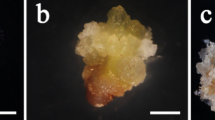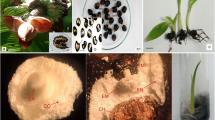Summary
Conversion (plant production) was obtained from direct-planting alfalfa somatic embryos and encapsulated somatic embryos (artificial seeds) of alfalfa into a growth chamber and greenhouse. The embryos were planted in a commercial soil potting mix under nonsterile conditions in a manner similar to zygotic seed. Embryo maturation with abscisic acid (ABA), prior to planting, gave 48% conversion in soil under growth chamber conditions. Under greenhouse conditions, 64% conversion was obtained when humidified air was used to prevent soil surface drying. Previously, conversion in soil was between 0–6% without the ABA maturation treatment. The replacement of ABA with mannitol or combinations of mannitol and ABA during maturation resulted in lower conversion in the growth chamber than with ABA alone. ABA may be promoting the accumulation of embryo storage reserves such as proteins and carbohydrates for growth after planting in the soil environment.
Similar content being viewed by others
References
Stuart, D.; Strickland, S. Somatic embryogenesis from cell cultures ofMedicago sativa L. I. The role of amino acid additions to the regeneration medium. Plant Sci. Let. 34:165–174; 1984.
Redenbaugh, K.; Paasch, B.; Nichol, J., et al. Somatic seeds: encapsulation of axexual embryos. Bio/technology 4:797–801; 1986.
Kitto, S.; Janick, J. Production of synthetic seeds by encapsulating asexual embryos of carrot. J. Amer. Soc. Hort. Sci. 110:227–282; 1985.
Kitto, S.; Janick, J. hardening treatments increase survival of synthetically-coated axesual embryos of carrot. J. Amer. Soc. Hort. Sci. 110;282–286; 1985.
Gray, D. Quiescence in monocotyledonous and dicotyledonous somatic embryos induced by dehydration. HortSci. 22:810–814; 1987.
Gray, D.; Conger, B.; Songstad, D. Desiccated quiescent somatic embryos of orchardgrass for use as synthetic seeds. In Vitro Cell. Dev. Biol. 23:29–33; 1987.
Baker, C.Synchronization and fluid sowing of carrot, Daucus carota somatic embryos. M.S. Thesis, University of Florida, 1985.
Redenbaugh, K.; Slade, D.; Viss, P., et al. Encapsulation of somatic embryos in synthetic seed coats. HortSci. 22:803–809; 1987.
Stuart, D.; Strickland, S. Somatic embryogenesis from cell cultures ofMedicago sativa L. II. The interaction of amino acids with ammonium. Plant Sci. Let. 34:175–181; 1984.
Schenk, R.; Hildebrandt, A. Medium and techniques for induction and growth of monocotyledonous and dicotyledonous plant cell cultures. Can. J. Bot. 50:199–204; 1972.
Walker, K.; Sato, S. Morphogenesis in callus tissue ofMedicago sativa: the role of ammonium ion in somatic embryogenesis. Plant Cell Tis. Org. Cult. 1:109–121; 1981.
Walker, K.; Wendeln, M.; Jaworski, E. Organogenesis in callus tissue ofMedicago sativa. The temporal separation of induction processes from differentiation processes. Plant Sci. Let. 16:23–30; 1979.
Finkelstein, R.; Tenbarge, K.; Shumway, J., et al. Role of ABA in maturation of rapeseed embryos. Plant Physiol. 78:630–636; 1985.
Eisenberg, A.; Mascarenhas, J. Abscisic acid and the regulation of synthesis of specific seed proteins and their messenger RNAs during culture of soybean embryos. Planta 166:505–514; 1985.
Choinski, J.; Trelease, R.; Doman, D. Control of enzyme activities in cotton cotyledons during maturation and germination. III. In vitro embryo development in the presence of abscisic acid. Planta 152:428–435; 1981.
Ackerson, R. Regulation of soybean embryogenesis by abscisic acid. J. Exp. Bot. 35:403–413; 1984.
Crouch, M.; Sussex, I. Development and storage-protein synthesis inBrassica napus L. embryos in vivo and in vitro Planta 153:64–74; 1981.
Morris, P.; Maddock, S.; Jones, M., et al. Changes in the levels of wheat- and barley-germ agglutinin during embryogenesis in vivo, in vitro, and during germination. Planta 166:407–413; 1985.
Morris, P.; Weiler, E.; Maddock, S., et al. Determination of endogenous abscisic acid levels in immature cereal embryos during in vitro culture. Planta 173:110–116; 1988.
Finkelstein R.; Crouch, M. Rapeseed embryo development in culture on high osmoticum is similar to that in seeds. Plant Physiol. 81:907–912; 1986.
Author information
Authors and Affiliations
Additional information
Plant Editors note: Proceedings from a special symposium entitled “Synthetic Seeds” presented at the 39th annual meeting of the Tissue Culture Association, Las Vegas, Nevada on June 16, 1988. Associate Editor Keith Redenbaugh organized the symposium and handled reviews of the manuscripts.
Rights and permissions
About this article
Cite this article
Fujii, J.A., Slade, D. & Redenbaugh, K. Maturation and greenhouse planting of alfalfa artificial seeds. In Vitro Cell Dev Biol 25, 1179–1182 (1989). https://doi.org/10.1007/BF02621271
Received:
Accepted:
Issue Date:
DOI: https://doi.org/10.1007/BF02621271




